
In the ethereal world of art and culture, the introduction of prestigious institutions into new realms often symbolizes a beacon of enlightenment and progress. Such was the promise when the esteemed Centre Pompidou, a venerated paragon of modern art in Paris, cast its eyes upon Jersey City with plans to erect a beacon of Franco-American cultural exchange. Yet, this vision has dimmed, caught in the web of fiscal scrutiny and political reassessment.
The nascent collaboration between Centre Pompidou and Jersey City, heralded as a significant expansion of the Parisian institution's global footprint, was poised to transform the local cultural landscape. Dubbed a future hub for avant-garde artistry and transatlantic dialogues, the project initially garnered enthusiasm. However, beneath the surface of anticipation, currents of contention stirred.
Recently, voices from New Jersey's corridors of power, predominantly Republican figures, have crescendoed in opposition, casting long shadows over the project's financial blueprint. Concerns pivot sharply on the allocation of taxpayer money, raising poignant questions about cost, cultural value, and public accountability. These deliberations have led to a somber pivot: New Jersey has declared the ambitious project "no longer viable," effectively defunding the Centre Pompidou’s planned museum in Jersey City.
This decision encapsulates a broader narrative of cultural endeavor entangled with fiscal conservatism. The Centre Pompidou’s aborted journey speaks to the volatile nexus where art meets policy, and where visionary aspirations grapple with pragmatic governance. For enthusiasts of the arts and advocates of global cultural synergy, the situation unfolds as a tableau of thwarted ambition, urging a reflection on the mechanisms that foster or foil cultural enterprises.
While some may perceive this as merely a setback, others view it as a symptomatic discourse on the priorities and pressures shaping public cultural initiatives today. The unfolding scenario in Jersey City might serve as a compelling case study in the annals of cultural policy, potentially setting precedents for future collaborations—or cautionary tales.
The epilogue of the Centre Pompidou’s Jersey City narrative is yet unwritten. Will this mark a retreat from bold cultural expansions, or might it inspire a recalibrated approach to nurturing art and culture in public spheres? As the discourse evolves, it beckons the guardians of culture, policymakers, and the public to discern the values and visions we champion in our communal quest for cultural enrichment.
In the labyrinthine interplay of art, finance, and governance, the story of the Centre Pompidou and Jersey City concludes not with a grand opening, but with a reflective pause—prompting introspection on the future landscapes of international cultural cooperation.